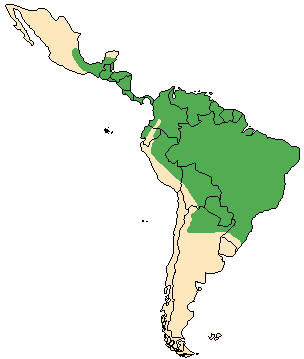![]() Return
to Artiodactyla
Return
to Artiodactyla
Classification
|
 Mazama
americana
Mazama
americana
Red brocket
![]()
Taxonomy
General Characteristics
Body Length: 70-130 cm / 2.3-4.3 ft.
Shoulder Height: 69-71 cm / 2.3-2.4 ft.
Tail Length: 8-15 cm / 3.2-6 in.
Weight: 16-25 kg / 35-55 lb.Adult colouration is fairly uniform: generally a bright reddish brown with the neck greyish. The belly and lower surface of the neck are lighter, while the underside of the tail is bright white. Fawns are born with white spots over a reddish coat. Overall, the red brocket's body shape is reminiscent of the African duikers, with a stout body, arched back, and slender limbs. The males alone carry the simple antlers which grow 10-13 cm / 4-5.2 inches in length. Generally just a spike, the antlers may be forked in very old animals. Like many tropical deer, a male red brocket may keep his antlers for over a year.
Ontogeny and Reproduction
Gestation Period: 200 days.
Young per Birth: 1, sometimes 2
Weaning: At 6 months.
Sexual Maturity: At 12 months.
Life span: 7-12 years.Although there is no fixed breeding or birthing season, many births occur from January to April as well as July to September depending on the locality and its conditions.
Ecology and Behavior
Red brockets are diurnal, spending most of their active time in dense forests searching for food. At dawn and dusk, however, they can often be seen foraging in nearby fields. Individuals inhabit small home ranges with a radius of up to 1 km / 0.6 miles. Extremely shy and wary, red brockets are difficult to observe. When danger is sensed, this diminutive deer will freeze in its position, and if startled will bound away for a short distance and then pause to look back at the disturbance. Compared to other deer species, they have low endurance and can be overtaken by common dogs. These small deer are exceptional swimmers, and have been seen crossing rivers over 300 meters / 328 yards wide. Population densities of about 1 animal per square kilometer were found in Surinam. The only known vocalization is a piercing cry.Family group: Solitary.
Diet: Mainly leaves, also buds, shoots, fruit, fungi, and grasses.
Main Predators: Humans, jaguar, puma, tayra, feral dogs, eagles, large snakes.
Distribution
Forest thickets near water throughout Central and South America.

Range Map (Redrawn from Whitehead, 1993)
Conservation Status
The red brocket is a common species.
Remarks
The largest brocket species, the red brocket is found in every Central and South American country, with the exception of Chile and Uruguay. Brocket is thought to be from broc (Old French) the tine of a stag's antler.
Mazame or macame was a Mexican name given to certain deer during the 17th century. -anus (Latin) suffix meaning belonging to: this petite deer occupies much of Central and South America.
Literature Cited
MacNamara, M. 1990. Guemals, Pudus, and Brockets (Genera Hippocamelus, Pudu, and Mazama). In Grzimek's Encyclopedia of Mammals. Edited by S. P. Parker. New York: McGraw-Hill. Volume 5, pp. 219-229.Nowak, R. M. [editor]. 1991. Walker's Mammals of the World (Fifth Edition). Baltimore: The Johns Hopkins University Press.
Whitehead, K. G. 1993. The Whitehead Encyclopedia of Deer. Stillwater, MN: Voyageur Press, Inc.
Wilson, D. E., and D. M. Reeder [editors]. 1993. Mammal Species of the World (Second Edition). Washington: Smithsonian Institution Press. Available online at http://nmnhwww.si.edu/msw/
Return to Artiodactyla

![]()
© Brent Huffman, www.ultimateungulate.com |
|
|